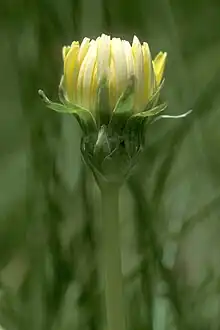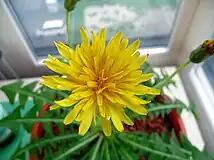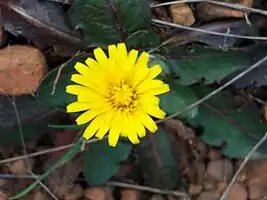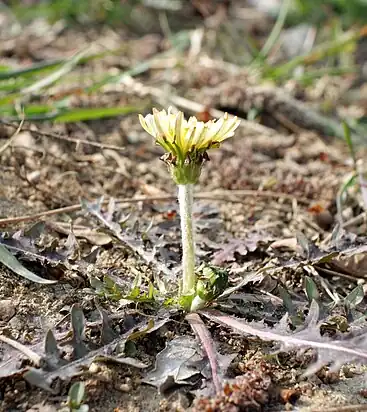Taraxacum
Taraxacum (/təˈræksəkəm/)[3] is a large genus of flowering plants in the family Asteraceae, which consists of species commonly known as dandelions. The scientific and hobby study of the genus is known as taraxacology.[4] The genus is native to Eurasia and North America, but the two most commonplace species worldwide, T. officinale (the common dandelion) and T. erythrospermum (the red-seeded dandelion), were introduced from Europe into North America, where they now propagate as wildflowers.[5] Both species are edible in their entirety.[6] The common name dandelion (/ˈdændəlaɪ.ən/ DAN-də-ly-ən; from French dent-de-lion 'lion's tooth') is also given to specific members of the genus.
| Taraxacum Temporal range: Miocene–recent[1] | |
|---|---|
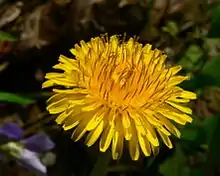 | |
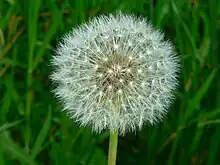 | |
| A dandelion flower head composed of numerous small florets (top). The seedhead is shown below it. | |
| Scientific classification | |
| Kingdom: | Plantae |
| Clade: | Tracheophytes |
| Clade: | Angiosperms |
| Clade: | Eudicots |
| Clade: | Asterids |
| Order: | Asterales |
| Family: | Asteraceae |
| Subfamily: | Cichorioideae |
| Tribe: | Cichorieae |
| Subtribe: | Crepidinae |
| Genus: | Taraxacum F. H. Wigg. |
| Type species | |
| Taraxacum officinale[2] | |
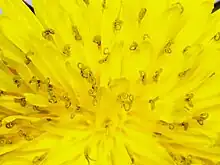
Like other members of the family Asteraceae, they have very small flowers collected together into a composite flower head. Each single flower in a head is called a floret. In part due to their abundance, along with being a generalist species, dandelions are one of the most vital early spring nectar sources for a wide host of pollinators.[7] Many Taraxacum species produce seeds asexually by apomixis, where the seeds are produced without pollination, resulting in offspring that are genetically identical to the parent plant.[8]
In general, the leaves are 50–250 mm (2–10 in) long or longer, simple, lobed-to-pinnatisect, and form a basal rosette above the central taproot. The flower heads are yellow to orange coloured, and are open in the daytime, but closed at night. The heads are borne singly on a hollow stem (scape) that is usually leafless and rises 10–100 mm (3⁄8–3+7⁄8 in) or more[5] above the leaves. Stems and leaves exude a white, milky latex when broken. A rosette may produce several flowering stems at a time. The flower heads are 20–50 mm (3⁄4–2 in) in diameter and consist entirely of ray florets. The flower heads mature into spherical seed heads sometimes called blowballs[9] or clocks (in both British and American English)[10][11][12][13] containing many single-seeded fruits called achenes. Each achene is attached to a pappus of fine hair-like material which enables wind-aided dispersal over long distances.
The flower head is surrounded by bracts (sometimes mistakenly called sepals) in two series. The inner bracts are erect until the seeds mature, then flex downward to allow the seeds to disperse. The outer bracts are often reflexed downward, but remain appressed in plants of the sections Palustria and Spectabilia. Between the pappus and the achene is a stalk called a beak, which elongates as the fruit matures. The beak breaks off from the achene quite easily, separating the seed from the parachute.
Description

The species of Taraxacum are tap-rooted, perennial, herbaceous plants, native to temperate areas of the Northern Hemisphere. The genus contains many species, which usually (or in the case of triploids, obligately) reproduce by apomixis, resulting in many local populations and endemism. In the British Isles alone, 234 microspecies (i.e. morphologically distinct clonal populations) are recognised in nine loosely defined sections, of which 40 are "probably endemic".[14] A number of species of Taraxacum are seed-dispersed ruderals that rapidly colonize disturbed soil, especially the common dandelion (T. officinale), which has been introduced over much of the temperate world. After flowering is finished, the dandelion flower head dries out for a day or two. The dried petals and stamens drop off, the bracts reflex (curve backwards), and the parachute ball opens into a full sphere. When development is complete, the mature seeds are attached to white, fluffy "parachutes" which easily detach from the seedhead and glide by wind, dispersing.
The seeds are able to cover large distances when dispersed due to the unique morphology of the pappus which works to create a unique type of vortex ring[15][16] that stays attached to the seed rather than being sent downstream. In addition to the creation of this vortex ring, the pappus can adjust its morphology depending on the moisture in the air. This allows the plume of seeds to close up and reduce the chance to separate from the stem, waiting for optimal conditions that will maximize dispersal and germination.[17][18]
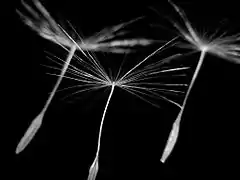
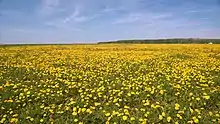
Similar plants
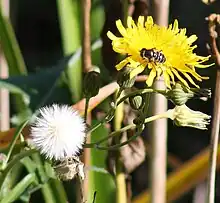
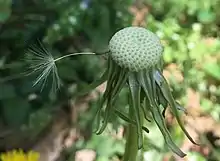
Many similar plants in the family Asteraceae with yellow flowers are sometimes known as false dandelions. Dandelion flowers are very similar to those of cat's ears (Hypochaeris). Both plants carry similar flowers, which form into windborne seeds. However, dandelion flowers are borne singly on unbranched, hairless and leafless, hollow stems, while cat's ear flowering stems are branched, solid, and carry bracts. Both plants have a basal rosette of leaves and a central taproot. However, the leaves of dandelions are smooth or glabrous, whereas those of cat's ears are coarsely hairy.
Early-flowering dandelions may be distinguished from coltsfoot (Tussilago farfara) by their basal rosette of leaves, their lack of disc florets, and the absence of scales on the flowering stem.[19]
Other plants with superficially similar flowers include hawkweeds (Hieracium) and hawksbeards (Crepis). These are readily distinguished by branched flowering stems, which are usually hairy and bear leaves.
Classification
The genus is taxonomically complex due to the presence of apomixis: any morphologically distinct clonal population would deserve its own microspecies. Phylogenetic approaches are also complicated by the accelerated mutation in apomixic lines and repeated ancient hybridization events in the genus.[20]
As of 1970, the group is divided into about 34 macrospecies or sections, and about 2000 microspecies;[21] some botanists take a much narrower view and only accept a total of about 60 (macro)species.[21] By 2015, the number has been revised to include 60 sections and about 2800 microspecies. 30 of these sections are known to reproduce sexually.[20]
About 235 apomictic and polyploid microspecies have been recorded in Great Britain and Ireland alone.[22]
Selected species
- Taraxacum albidum, the white-flowered Japanese dandelion, a hybrid between T. coreanum and T. japonicum
- Taraxacum algarbiense
- Taraxacum aphrogenes, the Paphos dandelion
- Taraxacum arcticum
- Taraxacum balticum
- Taraxacum brachyceras
- Taraxacum brevicorniculatum, frequently misidentified as T. kok-saghyz and a poor rubber producer[23]
- Taraxacum californicum, the California dandelion, an endangered species
- Taraxacum centrasiaticum, the Xinjiang dandelion
- Taraxacum ceratophorum, the horned dandelion, considered by some sources to be a North American subspecies of T. officinale (T. officinale subsp. ceratophorum)[24]
- Taraxacum coreanum
- Taraxacum desertorum
- Taraxacum erythrospermum, the red-seeded dandelion, often considered a variety of T. laevigatum (i.e., T. laevigatum var. erythrospermum)[25]
- Taraxacum farinosum, the Turkish dandelion
- Taraxacum holmboei, the Troödos dandelion
- Taraxacum hybernum
- Taraxacum japonicum, the Japanese dandelion, no ring of smallish, downward-turned leaves under the flower head
- Taraxacum kok-saghyz, the Kazakh dandelion, which produces rubber[26][23]
- Taraxacum laevigatum, the rock dandelion, achenes reddish brown and leaves deeply cut throughout the length, inner bracts' tips are hooded
- Taraxacum lissocarpum
- Taraxacum minimum
- Taraxacum mirabile
- Taraxacum officinale (syn. T. officinale subsp. vulgare), the common dandelion, found in many forms
- Taraxacum pankhurstianum, the St. Kilda dandelion
- Taraxacum platycarpum, the Korean dandelion
- Taraxacum pseudoroseum
- Taraxacum suecicum
T. albidum
|
T. californicum
|
T. japonicum
|
T. laevigatum
|
T. officinale
|
T. platycarpum
|
Cultivars
- 'Amélioré à Coeur Plein' yields an abundant crop without taking up much ground, and tends to blanch itself naturally, due to its clumping growth habit.
- 'Broad-leaved' - The leaves are thick and tender and easily blanched. In rich soils, they can be up to 60 cm (2') wide. Plants do not go to seed as quickly as French types.
- 'Vert de Montmagny' is a large-leaved, vigorous grower, which matures early.[27]
History
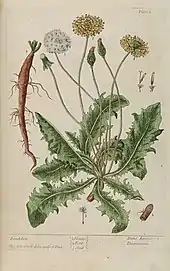
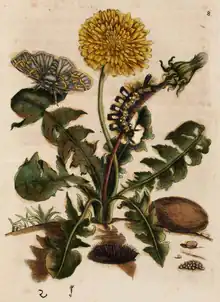
Dandelions are thought to have evolved about 30 million years ago in Eurasia.[28] Fossil seeds of Taraxacum tanaiticum have been recorded from the Pliocene of southern Belarus.[29] Dandelions have been used by humans for food and as an herb for much of recorded history. They were well known to ancient Egyptians, Greeks and Romans, and are recorded to have been used in traditional Chinese medicine for over a thousand years. The plant was used as food and medicine by Native Americans.[30] Dandelions were probably brought to North America on the Mayflower for their supposed medicinal benefits.[31]
Etymology

The Latin name Taraxacum originates in medieval Arabic writings on pharmacy. The scientist Al-Razi around 900 CE wrote "the tarashaquq is like chicory". The scientist and philosopher Ibn Sīnā around 1000 CE wrote a book chapter on Taraxacum. Gerard of Cremona, in translating Arabic to Latin around 1170, spelled it tarasacon.[32]
Common names
The English name, dandelion, is a corruption of the French dent de lion[33] meaning "lion's tooth", referring to the coarsely toothed leaves. The plant is also known as blowball, cankerwort, doon-head-clock, witch's gowan, milk witch, lion's-tooth, yellow-gowan, Irish daisy, monks-head, priest's-crown, and puff-ball;[34] other common names include faceclock, pee-a-bed, wet-a-bed,[35] swine's snout,[36] white endive, and wild endive.[37]
The English folk name "piss-a-bed" (and indeed the equivalent contemporary French pissenlit) refers to the strong diuretic effect of the plant's roots.[38] In various northeastern Italian dialects, the plant is known as pisacan ("dog pisses"), because they are found at the side of pavements.[39] In Swedish, it is called maskros (worm rose) after the nymphs of small insects (thrips larvae) usually present in the flowers.[40]
Nutrition
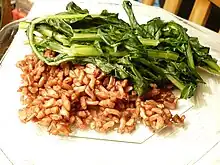
Raw dandelion greens contain high amounts of vitamins A, C, and K, and are moderate sources of calcium, potassium, iron, and manganese.[41] Raw dandelion greens are 86% water, 9% carbohydrates, 3% protein, and 1% fat.[41] A 100 gram (3+1⁄2oz) reference amount supplies 45 Calories.[41]
Phytochemicals
The raw flowers contain diverse phytochemicals, including polyphenols, such as flavonoids apigenin, isoquercitrin (a quercetin-like compound), and caffeic acid, as well as terpenoids, triterpenes, and sesquiterpenes.[42] The roots contain a substantial amount of the prebiotic fiber inulin. Dandelion greens contain lutein.[43]
Taraxalisin, a serine proteinase, is found in the latex of dandelion roots.[44][45] Maximal activity of the proteinase in the roots is attained in April, at the beginning of plant development after the winter period.[45] Each dandelion seed has a mass(weight) of 500 micrograms or 0.0005g (1/125 of a grain).
Properties
Edibility
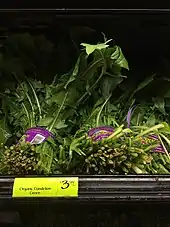
The entire plant, including the leaves, stems, flowers, and roots, is edible and nutritious, with nutrients such as vitamins A and K as well as calcium and iron. [46] Dandelions are found on six continents and have been gathered for food since prehistory, but the varieties commercially cultivated for consumption are mainly native to Eurasia and North America. A perennial plant, its leaves grow back if the taproot is left intact. To make leaves more palatable, they are often blanched to remove bitterness,[47] or sauteed in the same way as spinach.[48] Dandelion greens have been a part of traditional Kashmiri cuisine, Spanish cuisine, Italian cuisine, Albanian cuisine, Slovenian, Sephardic Jewish, Chinese, Greek cuisine (χόρτα) and Korean cuisines. In Crete, the leaves of a variety called 'Mari' (Μαρί), 'Mariaki' (Μαριάκι), or 'Koproradiko' (Κοπροράδικο) are eaten by locals, either raw or boiled, in salads. T. megalorhizon, a species endemic to Crete, is eaten in the same way; it is found only at high altitudes (1,000–1,600 metres (3,300–5,200 ft)) and in fallow sites, and is called pentaramia (πενταράμια) or agrioradiko (αγριοράδικο).[49]
The flower petals, along with other ingredients, usually including citrus, are used to make dandelion wine. Its ground, roasted roots can be used as a caffeine-free coffee alternative.[50] Dandelion was also traditionally used to make the traditional British soft drink dandelion and burdock, and is one of the ingredients of root beer. Dandelions were once considered delicacies by the Victorian gentry, who used them mostly in salads and sandwiches.
Dye
The yellow flowers can be dried and ground into a yellow-pigmented powder and used as a dye.[51]
Allergies
Dandelion pollen may cause allergic reactions when eaten, or adverse skin reactions in sensitive individuals. Contact dermatitis after handling has also been reported, probably from the latex in the stems and leaves.[52]
Herbalism
Dandelion has been used in traditional medicine in Europe, North America, and China.[42]
Food for wildlife
Dandelions do not depend on wildlife for distribution or pollination; however much of wildlife benefits from the abundance of the plant. Rabbits, wild turkeys, white-tailed deer, eastern chipmunks, bobwhite quail, and many species of birds will consume the seeds and foliage. Additionally, many insects will collect nectar from the flower, especially in early spring when there are very few other flowers in bloom.[53]
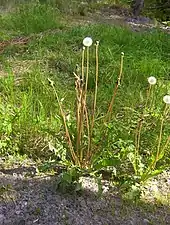
Seeds
Taraxacum seeds are an important food source for certain birds (linnets, Linaria spp.).[54]
Nectar
Szabo studied nectar secretion in a dandelion patch over two years (59.2 and 8.9 flowers per square metre (5.50 and 0.83/sq ft) in 1981 and 1982). He measured average nectar volume at 7.4 μl/flower in 1981 and 3.7 μl/flower in 1982. The flowers tended to open in the morning and close in the afternoon with the concentrations significantly higher on the second day.[55][56]
Dandelions are also important plants for Northern Hemisphere bees, providing an important source of nectar and pollen early in the season.[57] They are also used as a source of nectar by the pearl-bordered fritillary (Boloria euphrosyne), one of the earliest emerging butterflies in the spring.
Leaves
Dandelions are used as food plants by the larvae of some species of Lepidoptera (butterflies and moths).
Invasive species
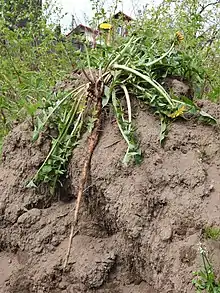
Dandelions can cause significant economic damage as an invasive species and infestation of other crops worldwide;[58] in some jurisdictions, the species T. officinale is listed as a noxious weed.[58][59] It can also be considered invasive in protected areas such as national parks. For example, Denali National Park and Preserve in Alaska lists Taraxacum officinale as the most common invasive species in the park [60] and hosts an annual "Dandelion Demolition" event where volunteers are trained to remove the plant from the park's roadsides.[61]
Benefits to gardeners
With a wide range of uses, the dandelion is cultivated in small gardens to massive farms. It is kept as a companion plant; its taproot brings up nutrients for shallow-rooting plants. It is also known to attract pollinating insects and release ethylene gas, which helps fruit to ripen.[62]
Cultural importance
It has been a Western tradition for someone to blow out a dandelion seedhead and think of a wish they want to come true.[63]
Five dandelion flowers are the emblem of White Sulphur Springs, West Virginia.[64] The citizens celebrate spring with an annual Dandelion Festival.
The dandelion is the official flower of the University of Rochester in New York State, and "Dandelion Yellow" is one of the school's official colors. "The Dandelion Yellow" is an official University of Rochester song.[65]
Inspiration for engineering
The ability of dandelion seeds to travel as far as a kilometer in dry, windy and warm conditions, has been an inspiration for designing light-weight passive drones.
In 2018, researchers discovered that dandelion seeds have a separated vortex ring.[66] This work provided evidence that dandelion seeds have fluid behavior around fluid-immersed bodies that may help understand locomotion, weight reduction and particle retention in biological and man-made structures.
In 2022, researchers at the University of Washington demonstrated battery-free wireless sensors and computers that mimic dandelion seeds and can float in the wind and disperse across a large area.[67]
As a source of natural rubber
Dandelions secrete latex when the tissues are cut or broken, yet in the wild type, the latex content is low and varies greatly. Taraxacum kok-saghyz, the Russian dandelion, is a species that produced industrially useful amounts during WW2. Using modern cultivation methods and optimization techniques, scientists in the Fraunhofer Institute for Molecular Biology and Applied Ecology (IME) in Germany developed a cultivar of the Russian dandelion that is suitable for current commercial production of natural rubber. The latex produced exhibits the same quality as the natural rubber from rubber trees.[68] In collaboration with Continental AG, IME is building a pilot facility. As of May 2014, the first prototype test tires made with blends from dandelion-rubber are scheduled for testing on public roads over the next few years.[69] In December 2017, Linglong Group Co. Ltd., a Chinese company, invested $450 million into making commercially viable rubber from dandelions.[70]
References
- Rubar Hussein M. Salih; Ľuboš Majeský; Trude Schwarzacher; R. Gornall; Pat Heslop-Harrison (9 February 2017). "Complete chloroplast genomes from apomictic Taraxacum (Asteraceae): Identity and variation between three microspecies". PLOS ONE. 12 (2). e0168008. Bibcode:2017PLoSO..1268008M. doi:10.1371/journal.pone.0168008. PMC 5300115. PMID 28182646.
- Adrian John Richards (1985). "Sectional nomenclature in Taraxacum (Asteraceae)". Taxon. 34 (4): 633–644. doi:10.2307/1222201. JSTOR 1222201.
- "Taraxacum". Merriam-Webster.com Dictionary.
- Greenwood, Barbara (2015). "Don't Dismiss the Dandelion".
- Brouillet, Luc. "Taraxacum F. H. Wiggers, Prim. Fl. Holsat. 56. 1780". Flora of North America.
- "Wild About Dandelions". Mother Earth News. 1 April 2008.
- "Let dandelions grow. Bees, beetles and birds need them". The Guardian. 12 May 2015.
- Doll, J. & Trower, T. "Dandelion". WeedScience. University of Wisconsin. Archived from the original on 22 October 2008.
- "blowball". McGraw-Hill Dictionary of Scientific & Technical Terms (6th ed.). McGraw-Hill Companies. 2003. Retrieved 26 January 2013.
- "blowball". CollinsDictionary.com. HarperCollins.
- "blowball". InfoPlease Dictionary.
- "dandelion clock". Longman English Dictionary Online. Pearson. Retrieved 2 June 2019.
- "clock". The American Heritage Dictionary of the English Language (5th ed.). HarperCollins.
- Stace, C. A. (2010). New Flora of the British Isles (Third ed.). Cambridge, U.K.: Cambridge University Press. p. 712. ISBN 9780521707725.
- Cummins, Cathal; Seale, Madeleine; Macente, Alice; Certini, Daniele; Mastropaolo, Enrico; Viola, Ignazio Maria; Nakayama, Naomi (2018). "A separated vortex ring underlies the flight of the dandelion" (PDF). Nature. 562 (7727): 414–418. Bibcode:2018Natur.562..414C. doi:10.1038/s41586-018-0604-2. ISSN 0028-0836. PMID 30333579. S2CID 52988814.
- Ledda, P. G.; Siconolfi, L.; Viola, F.; Camarri, S.; Gallaire, F. (2 July 2019). "Flow dynamics of a dandelion pappus: A linear stability approach". Physical Review Fluids. 4 (7): 071901. Bibcode:2019PhRvF...4g1901L. doi:10.1103/physrevfluids.4.071901. hdl:11568/998044. ISSN 2469-990X. S2CID 198429309.
- Seale, Madeleine; Zhdanov, Oleksandr; Cummins, Cathal; Kroll, Erika; Blatt, Michael R; Zare-Behtash, Hossein; Busse, Angela; Mastropaolo, Enrico; Viola, Ignazio Maria (7 February 2019). "Moisture-dependent morphing tunes the dispersal of dandelion diaspores". doi:10.1101/542696.
{{cite journal}}: Cite journal requires|journal=(help) - Loebach, Christopher A. (2015). Investigating seed dispersal distances and long distance dispersal mechanisms of the invasive plant, Alliaria Petiolata. Illinois State University. ISBN 9781321782141. OCLC 988948576.
- Blamey, M.; Fitter, R.; Fitter, A (2003). Wild flowers of Britain and Ireland: The Complete Guide to the British and Irish Flora. London: A & C Black. p. 274. ISBN 978-1408179505.
- Kirschner, Jan; Záveská Drábková, Lenka; Štěpánek, Jan; Uhlemann, Ingo (April 2015). "Towards a better understanding of the Taraxacum evolution (Compositae–Cichorieae) on the basis of nrDNA of sexually reproducing species". Plant Systematics and Evolution. 301 (4): 1135–1156. doi:10.1007/s00606-014-1139-0. S2CID 17903814.
- A. J. Richards (1970). "Eutriploid facultative agamospermy in Taraxacum". New Phytologist. 69 (3): 761–774. doi:10.1111/j.1469-8137.1970.tb02461.x. JSTOR 2430530.
- Richards, A.J. (1997). Dandelions of Great Britain and Ireland (Handbooks for Field Identification). Botanical Society of the British Isles Publications. p. 330. ISBN 978-0-901158-25-3.
- Nowicki, Marcin; Zhao, Yichen; Boggess, Sarah L.; Fluess, Helge; Payá-Milans, Miriam; Staton, Margaret E.; Houston, Logan C.; Hadziabdic, Denita; Trigiano, Robert N. (13 February 2019). "Taraxacum kok-saghyz (rubber dandelion) genomic microsatellite loci reveal modest genetic diversity and cross-amplify broadly to related species". Scientific Reports. 9 (1): 1915. Bibcode:2019NatSR...9.1915N. doi:10.1038/s41598-019-38532-8. ISSN 2045-2322. PMC 6374447. PMID 30760810.
- "Alberta Biodiversity Monitoring Institute - Taraxacum ceratophorum". Archived from the original on 8 July 2014. Retrieved 29 August 2013.
- "Flora of North America". Efloras.org. Retrieved 29 August 2012.
- "Plants for a Future Search Error". www.ibiblio.org. Retrieved 17 April 2017.
- "Dandelion". Fondation Louis Bonduelle. 5 October 2016.
- "Gardening in Western Washington: Dandelions". Gardening.wsu.edu. 4 May 2003. Archived from the original on 26 June 2012. Retrieved 29 August 2012.
- The Pliocene flora of Kholmech, southeastern Belarus and its correlation with other Pliocene floras of Europe by Felix Yu. VELICHKEVICH and Ewa ZASTAWNIAK - Acta Palaeobot. 43(2): 137–259, 2003
- Clarke, Charlotte Bringle (1977). Edible and useful plants of California. Berkeley: University of California Press. p. 191. ISBN 978-0-520-03261-3.
- "Dandelions". Maine Organic Farmers and Gardeners Association. Archived from the original on 20 February 2017. Retrieved 17 April 2017.
- Reported in An Etymological Dictionary of the English Language, by Walter W. Skeat (1888) (Downloadable at Archive.org). In An Etymology Dictionary of Modern English by Ernest Weekley (1921) it is reported that Arabic طرشقون tarashaqun is derivable in turn from Persian تلخ چکوک talkh chakok, bitter herb (Downloadable at Archive.org).
- S. Potter & L. Sargent (1973) Pedigree: essays on the etymology of words from nature. Collins New Naturalist series Volume 56
- Britton, N. F.; Brown, Addison (1970). An illustrated flora of the northern United States and Canada: from Newfoundland to the parallel of the southern boundary of Virginia, and from the Atlantic Ocean westward to the 102d meridian. New York: Dover Publications. p. 315. ISBN 978-0-486-22644-6.
- "Common Dandelion_Family: Asteraceae" (PDF).
- Loewer, Peter (2001). Solving weed problems. Guilford, Conn.: Lyons Press. p. 210. ISBN 978-1-58574-274-5.
Swine's Snout.
- "Dandelion clock". TheFreeDictionary.com.
- Taylor, Joseph (1819). Antiquitates curiosae: the etymology of many remarkable old sayings, proverbs and singular customs explained by Joseph Taylor (2nd ed.). T&J Allman. p. 97.
- Anon. "Dandelion - far more than a weed" (PDF). Frapez.com. Frapez soothie spa. Archived from the original (PDF) on 11 July 2011. Retrieved 30 May 2010.
- "Den virtuella floran: Taraxacum F. H. Wigg. - Maskrosor" (in Swedish). Linnaeus.nrm.se. Retrieved 3 July 2010.
- "Dandelion greens, raw". Nutritiondata.com, Conde Nast Inc. Retrieved 7 March 2011.
- Katrin Schütz, Reinhold Carle & Andreas Schieber (2006). "Taraxacum—a review on its phytochemical and pharmacological profile". Journal of Ethnopharmacology. 107 (3): 313–323. doi:10.1016/j.jep.2006.07.021. PMID 16950583.
- "Carotenoids". Micronutrient Information Center, Linus Pauling Institute, Oregon State University. 1 July 2016. Retrieved 27 June 2019.
- Bogacheva, A. M.; Rudenskaya, G. N.; Preusser, A; Tchikileva, I. O.; Dunaevsky, Y. E.; Golovkin, B. N.; Stepanov, V. M. (1999). "A new subtilisin-like proteinase from roots of the dandelion Taraxacum officinale Webb S. L". Biochemistry. Biokhimiia. 64 (9): 1030–7. PMID 10521720.
- Rudenskaya, G. N.; Bogacheva, A. M.; Preusser, A.; Kuznetsova, A. V.; Dunaevsky YaE, null; Golovkin, B. N.; Stepanov, V. M. (23 October 1998). "Taraxalisin -- a serine proteinase from dandelion Taraxacum officinale Webb s.l". FEBS Letters. 437 (3): 237–240. doi:10.1016/s0014-5793(98)01243-5. ISSN 0014-5793. PMID 9824298. S2CID 43872064.
- Osborne, Tegan (11 May 2016). "Edible weeds that are safe to eat and how you can use them". ABC News (Australia). Retrieved 24 May 2021.
- McGee, Harold (2004). "A survey of common vegetables". On Food and Cooking: the science and lore of the kitchen. New York: Scribner. p. 320. ISBN 978-0-684-80001-1.
- sautéed Dandelion Greens, ItalianFoodForever.com
- Kleonikos G. Stavridakis; Κλεόνικος Γ. Σταυριδάκης (2006). Wild edible plants of Crete - Η Άγρια βρώσιμη χλωρίδα της Κρήτης. Rethymnon Crete. ISBN 978-960-631-179-6.
- Castronovo Fusco, MA (15 April 2008). "Dandelion as underrated as underfoot". New Jersey On-Line. Retrieved 7 March 2011.
- Dyer, Anne. (1981). Dyes from natural sources. Bell & Hyman. ISBN 0713519371. OCLC 219915765.
- Bill Church (2006). Medicinal Plants, Trees, & Shrubs of Appalachia – A Field Guide. Lulu.com. p. 28. ISBN 978-1-4116-4486-1.
- "Out My Backdoor: In Defense of Dandelions | Department Of Natural Resources Division". georgiawildlife.com. Retrieved 16 October 2023.
- D. L. Buckingham & W. J. Peach (2005). "The influence of livestock management on habitat quality for farmland birds". Animal Science. 81 (2): 199–203. doi:10.1079/ASC50700199.
- Stewart-Wade, S. M.; Neumann, S.; Collins, L. L.; Boland, G. J. (1 October 2002). "The biology of Canadian weeds. 117. Taraxacum officinale G. H. Weber ex Wiggers". Canadian Journal of Plant Science. Canadian Science Publishing. 82 (4): 825–853. doi:10.4141/p01-010. ISSN 0008-4220. S2CID 85676502.
- Tibor I. Szabo, Nectar Secretion in Dandelion, Journal of Apicultural Research, Volume 23, 1984 - Issue 4
- Pellett, Frank Chapman (1920). American Honey Plants; Together With Those Which Are of Special Value to the Beekeeper as Sources of Pollen. American Bee Journal Publication. p. 178. ISBN 978-1-152-86271-5.
- Stewart-Wade, S. M.; Newmann, S.; Collins, L. L.; Boland, G. J. (2002). "The biology of Canadian weeds. 117. Taraxacum officinale G.H. Weber ex Wiggers". Canadian Journal of Plant Science. 82 (4): 825–853. doi:10.4141/P01-010.
- J., Richardson (1 January 1985). "In praise of the archenemy". Audubon: 37–39. ISSN 0097-7136.
- Non native species National Park Service
- Love, Colleen Coulon Denali’s Dandelion Demolition returns after 2020 hiatus KTNA, June 17, 2021
- Anon. "Companion Planting for Vegetables & Plants". Country living and farm lifestyles. countryfarm-lifestyles.com. Retrieved 7 March 2011.
- Thong, Roseanne (September 2008). Wish: wishing traditions around the world. Chronicle Books. ISBN 9780811857161 – via Google Books.
- "Welcome to Main Street White Sulphur Springs...Make it home". Wssmainstreet.org. Archived from the original on 4 June 2010. Retrieved 3 July 2010.
- "Songs of the University of Rochester". Lib.rochester.edu. 14 January 2010. Retrieved 3 July 2010.
- Cummins, Cathal; Seale, Madeleine; Macente, Alice; Certini, Daniele; Mastropaolo, Enrico; Viola, Ignazio Maria; Nakayama, Naomi (October 2018). "A separated vortex ring underlies the flight of the dandelion". Nature. 562 (7727): 414–418. Bibcode:2018Natur.562..414C. doi:10.1038/s41586-018-0604-2. ISSN 0028-0836. PMID 30333579. S2CID 52988814.
- Iyer, Vikram; Gaensbauer, Hans; Daniel, Thomas L.; Gollakota, Shyamnath (17 March 2022). "Wind dispersal of battery-free wireless devices". Nature. 603 (7901): 427–433. Bibcode:2022Natur.603..427I. doi:10.1038/s41586-021-04363-9. ISSN 0028-0836. PMID 35296847. S2CID 247499662.
- "Making Rubber from Dandelion Juice". Science Daily. 28 October 2013. Retrieved 22 November 2013.
- "Fraunhofer and Continental come together when the dandelion rubber meets the road". 14 October 2013. Retrieved 14 December 2016.
- "Linglong to fund research into dandelion rubber | Rubber and Plastics News". 20 December 2017.
External links
 Media related to Taraxacum at Wikimedia Commons
Media related to Taraxacum at Wikimedia Commons

